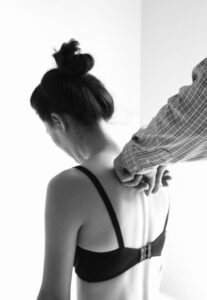The Ten series is the primary method of conducting Rolfing® Structural Integration. Each Session takes approximately 70 minutes, and the entire series is done over a span of at least 6 weeks and possibly much longer. The Ten series can be divided into three distinct sections: opening/sleeve 1-3, core 4-7, and closing/integrative8-10.
 Sessions 1-3:
Sessions 1-3:
-Sessions 1-3 strive to loosen surface layers of connective tissue so that the surface of the body can be ‘opened’ and deeper work can be done.
Session 1: The quality of breath is enhanced through opening the torso. This is accomplished through work on the upper arms, rib cage, chest, back, axilla, and diaphragm. Opening also started along the upper leg, hamstrings, neck, and spine. The client’s deep tension will be exposed after this session as the outer sleeve will no longer conceal it.
Session 2: Structural bilateral support is achieved by working on balancing the tissues of the feet and lower legs. This is to start from the ground up as if building the foundation of a building. The client will notice a change in connection to the ground after this session.
Session 3: Work is done on the entire lateral line of a person to balance them front and back in an opening fashion. Client is not ‘open’ for deep work.
I am 63 years old and have been to numerous doctors because of a “balance/sense of rocking” disorder called Chronic Subjective Dizziness that I was diagnosed with 11 years ago. I have tried physical therapy, chiropractic care and massage therapy and nothing has really helped until I found Gilman Rolfing. After only 2 sessions, I have already noticed a huge difference as I am much more balanced and the rocking sensation has subsided substantially!
Carter Warren
Sessions 4-7:
-Sessions 4-7 are referred to as “core” sessions and focus on tissue found between the bottom of the pelvis to the top of the head. The idea of core also includes the deep tissue of the legs for its role in support.
Session 4: Work is done from the inside arch of the foot and up the leg, to the pelvic floor. This balances the lower body and each leg in a medial/lateral orientation increasing bilateral support and mobility.
Session 5: The upper and lower body are connected through deep work on the psoas and other tissues connecting the two halves of the body. Clients usually drastically change the way they walk in this session.
Session 6: Work is done on the pelvic girdle, specifically the tissued restricting the sacrum’s relationship with the pelvis and upper femur. The result of which is elongation of the spine and an undulation of energy up the spine during walking.
Session 7: This session connects the head to the body in the last of the core session. It marks the completion from bottom to top. Work is also done inter-orally/inter-nasally which opens the face in the most pleasant of ways. Client’s have reported breathing differently or even looking different after this session.
“Integration” is emphasized throughout the remaining three sessions, as Session 8-10 provide an opportunity for the practitioner to blend previously established advancements into the body in a way that encourages smooth movement and natural coordination.
Sessions 8-9: In session 8 and 9 he practitioner determines how best to achieve integration, one session will focus on the lower body while the other fucuses on the upper body depending on the individual client.
Session 10: Also an integrative session, session 10 focuses on connecting all of the new changes in the body and encapsulating them so the client can go out into the world to use their new options of movement.
Post 10: Work is possible post ten, but it is ideal for the client to allow the new changes to settle into their body and become who they are over the next 6-9 months. The hallmark of a good ten series is that the client will change more in the months after the ten series than during it.